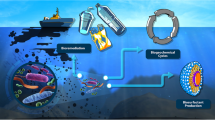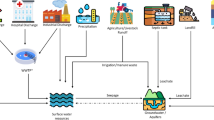Abstract
The widespread use of bisphenol S (BPS) as a bisphenol A substitute increases its potential of release into the aquatic environments. However, the degradation of BPS in aquatic systems is largely unknown, which will dictate its fate and toxicity. In this study, a bacterial consortium was enriched from river sediments and the dynamic changes of community structure during bacterial acclimation were studied. BPS degrading bacterial strains isolated from the consortium were identified by 16S rRNA analysis. The efficiency of the consortium and strains for BPS degradation were further evaluated. After 28 days of acclimation, the microbial diversity decreased significantly and four bacterial genera Hyphomicrobium, Pandoraea, Rhodococcus, and Cupriavidus with relative abundances of 5.1%–52.8% became dominant in the consortium. Total of two pure strains including Terrimonas pekingensis and Pseudomonas sp. were isolated from the consortium, using BPS as the sole carbon source. The consortium was highly efficient to degrade BPS, and 99% of BPS with an initial concentration of 50 mg/L was removed within 10 days at pH 7 and 30°C. In comparison with the consortium, a single strain cultures had lower BPS degradation efficiency. These findings indicate that BPS will degrade rapidly under aerobic conditions in river sediments and have implication for BPS-contaminated site remediation using the enriched consortium.





Similar content being viewed by others
References
Beck DA et al (2011) An integrated proteomics/transcriptomics approach points to oxygen as the main electron sink for methanol metabolism in Methylotenera mobilis. J Bacteriol 193:4758–4765
Borodina E, Kelly DP, Rainey FA, Ward-Rainey NL, Wood AP (2000) Dimethylsulfone as a growth substrate for novel methylotrophic species of Hyphomicrobium and Arthrobacter. Arch Microbiol 173:425–437
Cai L, Chen TB, Gao D, Yu J (2016) Bacterial communities and their association with the bio-drying of sewage sludge. Water Res 90:44–51
Chang BV, Yuan SY, Chiou CC (2011) Biodegradation of bisphenol-A in river sediment. J Environ Sci Health Part A 46:931 – 937
Chen D, Kannan K, Tan H, Zheng Z, Feng YL, Wu Y, Widelka M (2016) Bisphenol analogues other than BPA: environmental occurrence, human exposure, and toxicity-A review. Environ Sci Technol 50:5438–5453
Choi YJ, Lee LS (2017) Aerobic soil biodegradation of bisphenol (BPA) alternatives bisphenol S and bisphenol AF compared to BPA. Environ Sci Technol 51:13698–13704
Cuadrado V, Gomila M, Merini L, Giulietti AM, Moore ER (2010) Cupriavidus pampae sp. nov., a novel herbicide-degrading bacterium isolated from agricultural soil. Int J Syst Evol Microbiol 60:2606–2612
Danzl E, Sei K, Soda S, Ike M, Fujita M (2009) Biodegradation of bisphenol A, bisphenol F and bisphenol S in seawater. Int J Environ Res Public Health 6:1472–1484
El-Naas MH, Al-Muhtaseb SA, Makhlouf S (2009) Biodegradation of phenol by Pseudomonas putida immobilized in polyvinyl alcohol (PVA) gel. J Hazard Mater 164:720–725
Ghosh S, Chowdhury R, Bhattacharya P (2016) Mixed consortia in bioprocesses: role of microbial interactions. Appl Microbiol Biotechnol 100:4283–4295
Ike M et al. (2006) Biodegradation of a variety of bisphenols under aerobic and anaerobic conditions. J Water sci technol 53:153–159
Lambo AJ, Patel TR (2006) Cometabolic degradation of polychlorinated biphenyls at low temperature by psychrotolerant bacterium Hydrogenophaga sp. IA3-A. Curr Microbiol 53:48–52
Li F et al (2014) Fate and metabolism of tetrabromobisphenol A in soil slurries without and with the amendment with the alkylphenol degrading bacterium Sphingomonas sp. strain TTNP3. Environ Pollut 193:181–188
Li G, Xiong J, Wong PK, An T (2016) Enhancing tetrabromobisphenol A biodegradation in river sediment microcosms and understanding the corresponding microbial community. Environ Pollut 208:796–802
Ma Y, Zhao Y, Wang Y, Li X, Sun F, Corvini PF, Ji R (2017) Effects of Cu (2+) and humic acids on degradation and fate of TBBPA in pure culture of Pseudomonas sp. strain CDT. J Environ Sci (China) 62:60–67
Naderi M, Wong MY, Gholami F (2014) Developmental exposure of zebrafish (Danio rerio) to bisphenol-S impairs subsequent reproduction potential and hormonal balance in adults. Aquat Toxicol 148:195–203
Navarro-Llorens JM, Patrauchan MA, Stewart GR, Davies JE, Eltis LD, Mohn WW (2005) Phenylacetate catabolism in Rhodococcus sp. strain RHA1: a central pathway for degradation of aromatic compounds. J Bacteriol 187:4497–4504
Ogata Y, Goda S, Toyama T, Sei K, Ike M (2013) The 4-tert-butylphenol-utilizing bacterium Sphingobium fuliginis OMI can degrade bisphenols via phenolic ring hydroxylation and meta-cleavage pathway. Environ Sci Technol 47:1017–1023
Roelofs MJ, van den Berg M, Bovee TF, Piersma AH, van Duursen MB (2015) Structural bisphenol analogues differentially target steroidogenesis in murine MA-10 Leydig cells as well as the glucocorticoid receptor. Toxicology 329:10–20
Ronen Z, Abeliovich A (2000) Anaerobic-aerobic process for microbial degradation of tetrabromobisphenol A. Appl Environ Microbiol 66:2372–2377
Ruan T, Liang D, Song S, Song M, Wang H, Jiang G (2015) Evaluation of the in vitro estrogenicity of emerging bisphenol analogs and their respective estrogenic contributions in municipal sewage sludge in China. Chemosphere 124:150–155
Sahin N, Tani A, Kotan R, Sedlacek I, Kimbara K, Tamer AU (2011) Pandoraea oxalativorans sp. nov., Pandoraea faecigallinarum sp. nov. and Pandoraea vervacti sp. nov., isolated from oxalate-enriched culture. Int J Syst Evol Microbiol 61:2247–2253
Sakai K, Yamanaka H, Moriyoshi K, Ohmoto T, Ohe T (2007) Biodegradation of bisphenol A and related compounds by Sphingomonas sp. strain BP-7 isolated from seawater. Biosci Biotechnol Biochem 71:51–57
Sercu B, Nunez D, Van Langenhove H, Aroca G, Verstraete W (2005) Operational and microbiological aspects of a bioaugmented two-stage biotrickling filter removing hydrogen sulfide and dimethyl sulfide. Biotechnol Bioeng 90:259–269
Siddique T, Okeke BC, Arshad M, Frankenberger WT (2003) Enrichment and isolation of endosulfan-degrading microorganisms. J Environ Qual 32:47–54
Sohn JH, Kwon KK, Kang JH, Jung HB, Kim SJ (2004) Novosphingobium pentaromativorans sp. nov., a high-molecular-mass polycyclic aromatic hydrocarbon-degrading bacterium isolated from estuarine sediment. Int J Syst Evol Microbiol 54:1483–1487
Sun LN, Wang DS, Yang ED, Fang LC, Chen YF, Tang XY, Hua RM (2016) Cupriavidus nantongensis sp. nov., a novel chlorpyrifos-degrading bacterium isolated from sludge. Int J Syst Evol Microbiol 66:2335–2341
Toyama T, Sato Y, Inoue D, Sei K, Chang YC, Kikuchi S, Ike M (2009) Biodegradation of bisphenol A and bisphenol F in the rhizosphere sediment of Phragmites australis. J Biosci Bioeng 108:147–150
Voordeckers JW, Fennell DE, Jones K, Haggblom MM (2002) Anaerobic biotransformation of tetrabromobisphenol A, tetrachlorobisphenol A, and bisphenol A in estuarine sediments. Environ Sci Technol 36(4):696–701
Warren R et al (2004) Functional characterization of a catabolic plasmid from polychlorinated- biphenyl-degrading Rhodococcus sp. strain RHA1. J Bacteriol 186:7783–7795
Ying GG, Kookana RS (2005) Sorption and degradation of estrogen-like-endocrine disrupting chemicals in soil. Environ Toxicol Chem 24:2640–2645
Yan Z et al (2017) Bisphenol analogues in surface water and sediment from the shallow Chinese freshwater lakes: occurrence, distribution, source apportionment, and ecological and human health risk. Chemosphere 184:318–328
Acknowledgements
We ackonwledage the financial support from the National Natural Science Foundation of China (Grant Nos. 21876207 and 21607072), and a foundation for the author of Graduate Student’s Innovative Practice Program of Jiangsu Province (Grant No. 1280110004).
Author information
Authors and Affiliations
Corresponding authors
Rights and permissions
About this article
Cite this article
Wang, X., Chen, J., Ji, R. et al. Degradation of Bisphenol S by a Bacterial Consortium Enriched from River Sediments. Bull Environ Contam Toxicol 103, 630–635 (2019). https://doi.org/10.1007/s00128-019-02699-7
Received:
Accepted:
Published:
Issue Date:
DOI: https://doi.org/10.1007/s00128-019-02699-7




